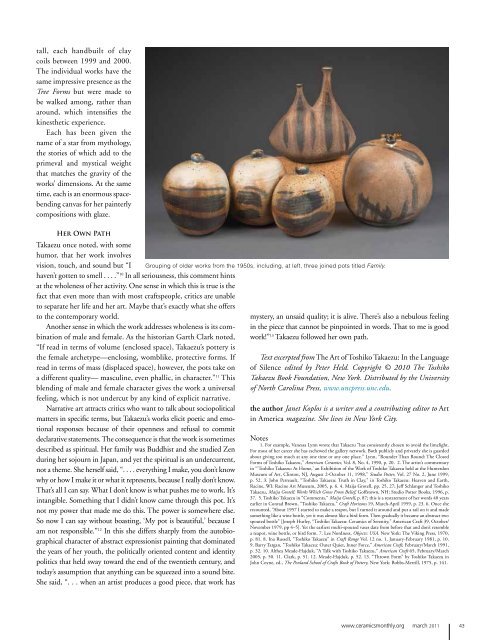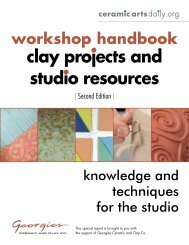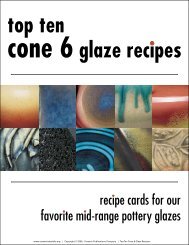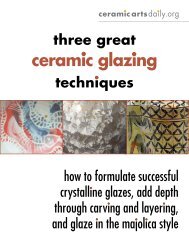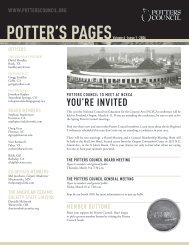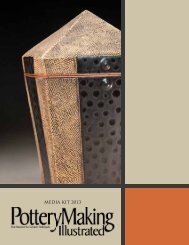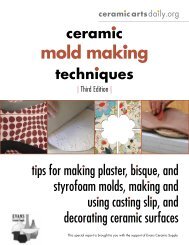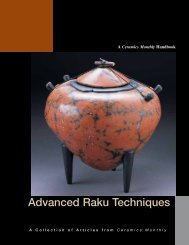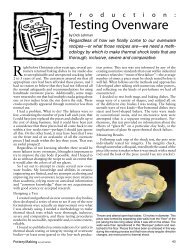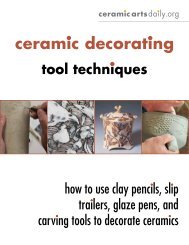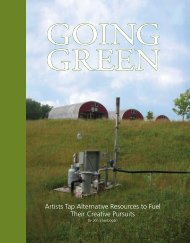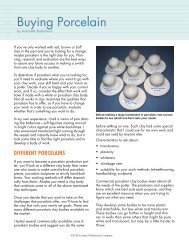Spotlight: Nick Joerling shifts gears Techno File - Ceramic Arts Daily
Spotlight: Nick Joerling shifts gears Techno File - Ceramic Arts Daily
Spotlight: Nick Joerling shifts gears Techno File - Ceramic Arts Daily
You also want an ePaper? Increase the reach of your titles
YUMPU automatically turns print PDFs into web optimized ePapers that Google loves.
tall, each handbuilt of clay<br />
coils between 1999 and 2000.<br />
The individual works have the<br />
same impressive presence as the<br />
Tree Forms but were made to<br />
be walked among, rather than<br />
around, which intensifies the<br />
kinesthetic experience.<br />
Each has been given the<br />
name of a star from mythology,<br />
the stories of which add to the<br />
primeval and mystical weight<br />
that matches the gravity of the<br />
works’ dimensions. At the same<br />
time, each is an enormous spacebending<br />
canvas for her painterly<br />
compositions with glaze.<br />
Her Own Path<br />
Takaezu once noted, with some<br />
humor, that her work involves<br />
vision, touch, and sound but “I<br />
haven’t gotten to smell . . . .” 10 In all seriousness, this comment hints<br />
at the wholeness of her activity. One sense in which this is true is the<br />
fact that even more than with most craftspeople, critics are unable<br />
to separate her life and her art. Maybe that’s exactly what she offers<br />
to the contemporary world.<br />
Another sense in which the work addresses wholeness is its combination<br />
of male and female. As the historian Garth Clark noted,<br />
“If read in terms of volume (enclosed space), Takaezu’s pottery is<br />
the female archetype—enclosing, womblike, protective forms. If<br />
read in terms of mass (displaced space), however, the pots take on<br />
a different quality— masculine, even phallic, in character.” 11 This<br />
blending of male and female character gives the work a universal<br />
feeling, which is not undercut by any kind of explicit narrative.<br />
Narrative art attracts critics who want to talk about sociopolitical<br />
matters in specific terms, but Takaezu’s works elicit poetic and emotional<br />
responses because of their openness and refusal to commit<br />
declarative statements. The consequence is that the work is sometimes<br />
described as spiritual. Her family was Buddhist and she studied Zen<br />
during her sojourn in Japan, and yet the spiritual is an undercurrent,<br />
not a theme. She herself said, “. . . . everything I make, you don’t know<br />
why or how I make it or what it represents, because I really don’t know.<br />
That’s all I can say. What I don’t know is what pushes me to work. It’s<br />
intangible. Something that I didn’t know came through this pot. It’s<br />
not my power that made me do this. The power is somewhere else.<br />
So now I can say without boasting, ‘My pot is beautiful,’ because I<br />
am not responsible.” 12 mystery, an unsaid quality; it is alive. There’s also a nebulous feeling<br />
in the piece that cannot be pinpointed in words. That to me is good<br />
work!”<br />
In this she differs sharply from the autobiographical<br />
character of abstract expressionist painting that dominated<br />
the years of her youth, the politically oriented content and identity<br />
politics that held sway toward the end of the twentieth century, and<br />
today’s assumption that anything can be squeezed into a sound bite.<br />
She said, “. . . when an artist produces a good piece, that work has<br />
13 Grouping of older works from the 1950s, including, at left, three joined pots titled Family.<br />
Takaezu followed her own path.<br />
Text excerpted from The Art of Toshiko Takaezu: In the Language<br />
of Silence edited by Peter Held. Copyright © 2010 The Toshiko<br />
Takaezu Book Foundation, New York. Distributed by the University<br />
of North Carolina Press, www.uncpress.unc.edu.<br />
the author Janet Koplos is a writer and a contributing editor to Art<br />
in America magazine. She lives in New York City.<br />
Notes<br />
1. For example, Vanessa Lynn wrote that Takaezu “has consistently chosen to avoid the limelight.<br />
For most of her career she has eschewed the gallery network. Both publicly and privately she is guarded<br />
about giving too much at any one time or any one place.” Lynn, “Rounder Than Round: The Closed<br />
Forms of Toshiko Takaezu,” American <strong>Ceramic</strong>s, Vol. 8, No. 4, 1990, p. 20. 2. The artist’s commentary<br />
in “’Toshiko Takaezu: At Home,’ an Exhibition of the Work of Toshiko Takaezu held at the Hunterdon<br />
Museum of Art, Clinton, NJ, August 2-October 11, 1998,” Studio Potter, Vol. 27 No. 2, June 1999,<br />
p. 52. 3. John Perreault, “Toshiko Takaezu: Truth in Clay,” in Toshiko Takaezu: Heaven and Earth,<br />
Racine, WI: Racine Art Museum, 2005, p. 6. 4. Maija Grotell, pp. 25, 27; Jeff Schlanger and Toshiko<br />
Takaezu, Maija Grotell: Works Which Grow From Belief, Goffstown, NH: Studio Potter Books, 1996, p.<br />
37. 5. Toshiko Takaezu in “Comments,” Maija Grotell, p. 87; this is a restatement of her words 40 years<br />
earlier in Conrad Brown, “Toshiko Takaezu,” Craft Horizons 19, March-April 1959, p. 23. 6. Once she<br />
recounted, “About 1957 I started to make a teapot, but I turned it around and put a tail on it and made<br />
something like a wine bottle, yet it was almost like a bird form. Then gradually it became an abstract two<br />
spouted bottle” [Joseph Hurley, “Toshiko Takaezu: <strong>Ceramic</strong>s of Serenity,” American Craft 39, October/<br />
November 1979, pp 4–5]. Yet the earliest multi-spouted vases date from before that and don’t resemble<br />
a teapot, wine bottle, or bird form. 7. Lee Nordness, Objects: USA. New York: The Viking Press, 1970,<br />
p. 81. 8. Ina Russell, “Toshiko Takaezu” in Craft Range Vol. 12 no. 1, January-February 1981, p. 10.<br />
9. Barry Targan, “Toshiko Takaezu: Outer Quiet, Inner Force,” American Craft, February/March 1991,<br />
p. 32. 10. Althea Meade-Hajduk, “A Talk with Toshiko Takaezu,” American Craft 65, February/March<br />
2005, p. 50. 11. Clark, p. 51. 12. Meade-Hajduk, p. 52. 13. “Thrown Form” by Toshiko Takaezu in<br />
John Coyne, ed., The Penland School of Crafts Book of Pottery, New York: Bobbs-Merrill, 1975, p. 141.<br />
www.ceramicsmonthly.org march 2011 43


